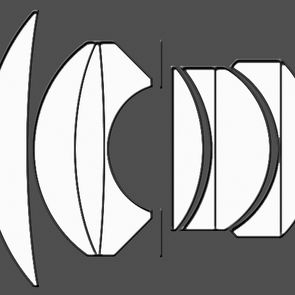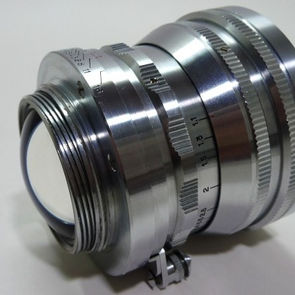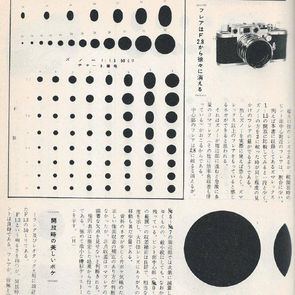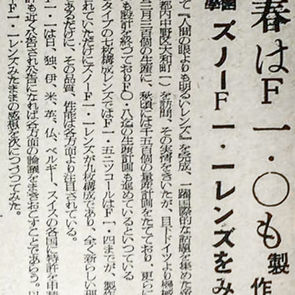ZUNOW 5cm F1.1 , written by Kenneth Min Zee
(updated on August 27, 2023)
History of ZUNOW 5cm F1.1
The origin of the name "ZUNOW" is believed to stem from the Japanese word "zuno," which translates to "brain." The conceptualization and subsequent development of the ZUNOW 5cm f1.1 lens began in 1943 against the backdrop of World War II. This high-speed lens was conceived to meet the specific needs of the Japanese Navy, particularly for aviation search and reconnaissance operations. It was officially introduced in 1953 under the guidance of Mr. Hamano, Michisaburo. Mr. Hamano transitioned from a naval background to work at Nippon Kogaku K.K. and later joined Teikoku Optical Industries. The meticulous development process spanned a decade, resulting in the creation of the ZUNOW 5cm F1.1 lens.
The ZUNOW 5cm F1.1 lens was initially priced at US$450 upon its debut in 1953. Adjusted for inflation, this amount equates to approximately US$5,152 in today's currency.
In terms of its optical arrangement, the ZUNOW 5cm F1.1 lens consists of 5 groups housing nine (9) elements, following the principles of a Sonnar-type design. This impressive optical configuration was available in mounts compatible with Contax rangefinders, Nikon rangefinders, and Leica thread mounts. The original version, known as Type 1, featured a rounded end and earned the nickname "Ping-Pong Ball."
The initial iteration of the lens faced significant issues, particularly at wide-open apertures. Problems included flare, an inconvenient protruding ball structure at the rear, and most importantly, a lack of desired brightness at F1.1 aperture. Consequently, this version received negative reviews.
During the same timeframe, two experts, Kenji Kunitomo from Nippon Kogaku (later known as Nikon) and Yoshitatsu Fujioka from Yashima Kogaku, joined Teikoku Koaku Kogyo Kabushiki Kaisha to address these problems. They collaborated to enhance the design, leading to the introduction of an improved model referred to as "Type 2" in 1955.
In this later model, the protruding ball structure at the lens's rear, a characteristic of the initial Type 1 model, underwent a complete redesign. It was transformed into a flat rear configuration consisting of 5 groups housing eight (8) elements, and effectively resolved the flare, protruding ball structure, and brightness issues at F1.1 aperture. As a result, the Type 2 model garnered more favorable reviews, thanks to the contributions of Kunitomo, Fujioka, and their teams. The manufacturing serial numbers for the later model started around the 5400 series.
Type 1 owners were provided with the opportunity for modification if they sought to address performance-related issues. This has led to the original "Ping-Pong Ball" Type 1 design becoming exceptionally scarce among Zunow lenses, possibly with fewer than 50 copies still in existence.
In 1954, Teikoku Kogaku Kenkyujo (Imperial Optical Research Institute) became Teikoku Kogaku Kogyo Kabushiki Kaisha (Imperial Optical Industry Corporation), and in 1955, the name changed again to Zunow Optics Kabushiki Kaisha. As a result, starting from the 5500 series, the lens's front ring engraving transitioned from "Teikoku Kougaku" to "Zunow Opt."
In 1955, Genta Fujitani stated the following in a photography industry magazine: "The first half of the aperture follows the Sonar type, while the latter half is the 'Zunow type,' developed after years of research. This design, using conventional optical glass, corrects aberrations remarkably well and provides an aperture larger than f/1.4 with ample back focus. The resulting image characteristics display residual spherical aberration up to about F2.8 from wide open, leading to a gentle softness.
Nevertheless, the amount of sine condition violation (OSC) remains minimal across all aperture settings, and coma aberration is barely noticeable. Off-axis aberrations are well managed, resulting in a soft yet generally unobtrusive overall image. Additionally, due to the lens's numerous elements and large diameter, a yellowish tint can affect natural light. Consequently, the traditional blue-violet coating has been substituted with an amber coating."
How Collectors View Zunow F1.1
The ZUNOW lens has garnered distinction for its exceptional performance and distinctive characteristics. It stands as a testament to the craftsmanship of the Japanese lens-making industry during the 1950s era. Its rarity and association with a bygone epoch further enhance its allure. The lens is notably compatible with the Leica, embracing the M-mount system, and has earned acclaim for its ability to render exquisite bokeh effects, akin to the sparkling brilliance of fireworks.
Despite its F1.1 aperture, the lens maintains a remarkable compact form, boasting a filter thread size of rare 54.5mm. In fact, its dimensions closely resemble those of the MS Optical 50mm F1.1 Sonnetar. Notably, We find the aperture ring design particularly appealing. Furthermore, the lens distinguishes itself from its Japanese counterparts through its unique focus scallop design, which departs from the typical bold aesthetics commonly observed in other lenses of Japanese origin.
About Serial Numbers:
At the announcement stage, it seems that serial numbers were in the 1500 range, but commercial production is said to have started from the 3500 range. There also appear to be prototypes in the 2500 range available in the market. Serial numbers were distributed by mount, and it appears that they were not assigned strictly in sequential order.
As mentioned above, the configuration with 5 groups and 8 elements started around the 5400 range. Around the 5500 range, the nameplate was changed to "Zunow Opt." Production seems to have continued until around the 6400 range. No instances from the 6500 range have been confirmed.
It is widely believed that numerous Type 1 versions have undergone modifications, involving a shift in the lens configuration to accommodate 5 groups and 8 elements. As a result, there are cases where lenses from initial production batches, which were originally anticipated to showcase the "Ping-Pong Ball" design, have instead been transformed into a flat design through these alterations.
There are both metric and feet markings. Coatings also appear to have changed over time. The rotation direction of the helicoid varies, with both clockwise and counterclockwise versions.
The total production number is said to be either 800 or 1000. In any case, it is a relatively small quantity. As mentioned early, I have never seen a ping-pong ball version before with my naked eye, and I believe there are less than 50 copies in existence.
How I view the Zunow F1.1 lenses
I currently have in possession total of four (4) Zunow 5cm F1.1 lenses and they are as follows:
-
Zunow 5cm F1.1 in Leica Thread Mount (LTM) with a 54.5mm filter size.
-
Zunow 5cm F1.1 in Nikon S-Mount, black paint version, with a 54.5mm filter size.
-
Zunow 5cm F1.1 in Nikon S-Mount, with a 55mm filter size, known to be an originally Ping Pong model Type 1, modified to Type 2. I do not know why the filter size is 55mm.
-
Zunow 5cm F1.1 in Leica Thread Mount (LTM) with a 54.5mm filter size, serviced at Kanto Camera in July 2023.
It sounds crazy, but I must admit I'm quite the enthusiast for vintage lenses especially with Zunow 5cm F1.1. Well, that is why I am an "Old Lens Junkie" However, in truth, each of these four lenses is distinct to me. They each exhibit different characteristics. I have also received confirmation from two well-respected old lens experts in Japan that the spacing between the five lens groups in each Zunow 5cm F1.1 lens is unique. Because of this, only a few experts are willing to undertake lens restoration if your Zunow lens has foggy elements. For instance, Hayata Camera won't accept such a job from you due to these intricate differences.
I am not that crazy about owning a Ping-Pong ball version, Type 1, because of the following known issues:
1) has serious flare issues.
2) could cost as much as three times Type 2,
3) do not want to bother buying it knowing it has low optical quality
4) and of course I do not know of anyone who owns one.
Although it is not marked, in any history books, my conclusion is Zunow Type 1 has 55mm filter diameter size, aperture opens clockwise, and the serial number is below 5,400.
Type 2 has 54.5mm diameter filter, aperture opens counterclockwise, and serial number starts from 5,400.
The helicoid direction to infinity is clockwise for Nikon S mount, Contax mount, and others, but counterclockwise for Leica Thread Mount. Leica version, and has infinity lock.
More photos and comments about Zunow lenses will be added later this year)













